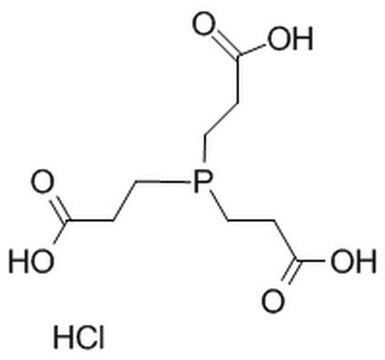52486
Tris(2-carboxyethyl)phosphin, auf Agarose CL-4B immobilisiert
Synonym(e):
TCEP-Agarose, Tris-(2-carboxyethyl)-phosphin-Agarose
Anmeldenzur Ansicht organisationsspezifischer und vertraglich vereinbarter Preise
Alle Fotos(1)
About This Item
UNSPSC-Code:
12352204
NACRES:
NA.25
Empfohlene Produkte
Lagertemp.
2-8°C
Anwendung
Tris(2-carboxyethyl)phosphine, immobilized on agarose CL-4B may be used in preliminary off-line experiments to study its ability to cleave disulfide bonds by both under flow conditions using sequential injection analysis (SI). It may also be used as a reducing agent in bio-tests for disrupting the disulfide bonds within and between the proteins.
Biochem./physiol. Wirkung
Tris(2-carboxyethyl)phosphine also referred to as TCEP reduces the disulfides by the usual mechanism of reduction of disulfides by phosphines in water. Tris(2-carboxyethyl)phosphine, immobilized on Agarose CL-4B,Trialkylphosphines (TCEP) are highly effective agents for reducing disulfide bonds in proteins, peptides and other disulfide bondcontaining molecules and are relatively non-reactive toward other functional groups. The trialkylphosphine TCEP was first described by Levison et al. as an odorless and efficient reductant of alkyl disulfides over a wide pH range. TCEP is stable in aqueous solutions and does not undergo the rapid oxidation that often occurs with other reducing agents such as dithiotreitol (DTT) and β-mercaptoethanol (BME, 2-ME). TCEP does not interfere with commonly used sulfhydryl-reactive reagents (e.g., maleimide crosslinkers). Nevertheless, many protocols require recovery of the reduced sample separate from the reducing agent. Our Tris(2-carboxyethyl)phosphine, immobilized on Agarose CL-4B eliminates the need to use laborious and troublesome gel filtration methods to separate the reduced sample from the reducing agent. Immobilized TCEP Disulfide Reducing Gel may be adapted conveniently to a variety of scales and formats. Examples are given for batch, spin cup column and gravity-flow column procedures. For small-scale reductions, the most complete sample recovery is made using the spin-cup column procedure (see Related Thermo Scientific Products Section).
Hinweis zur Analyse
Bioanalytiktests
Gel hat eine effektive TCEP-Konzentration ≥8 μmol/mL Gel
Gel hat eine effektive TCEP-Konzentration ≥8 μmol/mL Gel
Lagerklassenschlüssel
10 - Combustible liquids
WGK
WGK 3
Flammpunkt (°F)
Not applicable
Flammpunkt (°C)
Not applicable
Hier finden Sie alle aktuellen Versionen:
Besitzen Sie dieses Produkt bereits?
In der Dokumentenbibliothek finden Sie die Dokumentation zu den Produkten, die Sie kürzlich erworben haben.
Kunden haben sich ebenfalls angesehen
Preparation of Avidin Conjugates
Haugland, R.P. and Blalgat, M.K et al.
Methods in Molecular Biology, 189-190 (1998)
Burns, J.A.
The Journal of Organic Chemistry, 56, 2648-2648 (1991)
J C Han et al.
Analytical biochemistry, 220(1), 5-10 (1994-07-01)
The concentration of tris(2-carboxyethyl)phosphine (TCEP) can be conveniently determined by measuring the amount of 2-nitro-5-thiobenzoate (NTB) formed after reaction with 5,5'-dithiobis(2-nitrobenzoic acid) (DTNB). This method utilizes the fact that TCEP reduces DTNB rapidly and stoichiometrically to generate two equivalents of
Unser Team von Wissenschaftlern verfügt über Erfahrung in allen Forschungsbereichen einschließlich Life Science, Materialwissenschaften, chemischer Synthese, Chromatographie, Analytik und vielen mehr..
Setzen Sie sich mit dem technischen Dienst in Verbindung.





